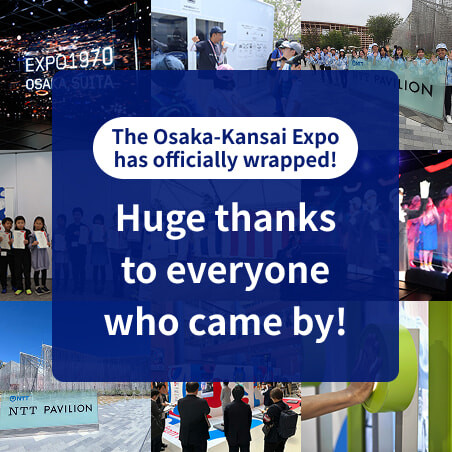Microsoft ends support for Internet Explorer on June 16, 2022.
We recommend using one of the browsers listed below.
- Microsoft Edge(Latest version)
- Mozilla Firefox(Latest version)
- Google Chrome(Latest version)
- Apple Safari(Latest version)
Please contact your browser provider for download and installation instructions.
Recycling and Reducing Environmental Impact
Our Policy and Approach
Please see the following page:
Organization for Implementation
Please see the following page:
Established under the Sustainability Committee described in the page on environmental management with the goal of achieving a waste recycling rate of 99% or more by 2030, the Green Innovation Committee works to identify the types and quantities of waste generated and investigate countermeasures to deal with it.
Targets and Performance
Increasing the reuse and recycling of communications equipment, mobile devices, and other technologies
Sustainability Indicators
*You can scroll horizontally
| Item | Fiscal 2024 target | Fiscal 2024 results | Fiscal 2025 target |
|---|---|---|---|
| (3) 2030: Waste recycling rate |
98.2% | 98.1% | At least 99% by 2030 |
| (4) Waste disposal (PCB) related legal violations |
0 cases | 5 cases* | 0 cases |
Boundary:NTT Domestic Group companies
*Upon discovering equipment containing high-concentration PCBs on-site, we immediately reported to the local government and the regional environmental office, and promptly arranged for proper disposal of the PCB waste. No penalties or fines were incurred.
Promoting the 3Rs (reduce, reuse, and recycle), working to reduce the amount of materials consumed by our business activities and reuse or recycle the resources that are consumed.
The NTT Group has established a target for achieving a 99% or higher recycling ratio of disposed waste generated by the NTT Group by fiscal 2030. We require a large amount of resources in order to sustain our business operations and provide various services including information communication. This is why we have set a target to contribute to both the avoidance of business continuity risks and achievement of closed loop recycling.
We recycled 98.3% of waste in fiscal 2024. We will continue promoting 3R with the aim of achieving our target of 99% or more. In addition, regarding dismantled telecommunications equipment, which makes up a part of that waste, we have achieved zero emissions (less than 1% final disposal of waste) for 20 consecutive years since fiscal 2004. In addition, in terms of construction waste, while there are various issues related to sorting mixed waste and the like, we are striving to stabilize our recycling rate, such as by selecting trustworthy companies, to recycle as much as possible.
■ Examples of Cable recycling

■ Examples of Mobile Phone Recycling
DOCOMO handles used smartphones as docomo Certified reused items. This involves checking basic functionality, cleaning the exteriors of smartphones charged to 80% or more, and putting them back into the market. Offering reused items such as these helps contribute to a circular economy society and streamlines the manufacture and shipping of new products, which is expected to reduce CO2 emissions in the supply chain. Mobile phones contain gold, silver, copper, palladium, etc., so they are a precious recycling resource in Japan where mineral resources are scarce. Since 1998, DOCOMO has collected and recycled used mobile phones. In 2001, we collaborated with the Telecommunications Carriers Association to build the Mobile Recycling Network for collecting mobile phones. In fiscal 2024, we collected about 3.2 million mobile phones for a total of nearly 131.14 million units at DOCOMO shops and other locations.
We have set indicators and targets such as those found below and work to increase the number of units recovered, creating opportunities to recover mobile phones for the purposes of reuse and recycling, as well as conducting PR. Not only do such initiatives contribute to the reduced depletion of valuable natural resources, they also reduce needless mining, contributing to a reduction in environmental impact and harm to human health caused by the mining of such resources.
*You can scroll horizontally
| Indicator / Target | Fiscal 2025 target | FY 2024 results |
|---|---|---|
| Recovery of unneeded mobile phones | Year-on-year improvement | 3.2 million units |
In addition to circuit boards, where rare metals are used, the plastic parts of the main unit, for example, are being recycled using plastic petrochemical conversion technology.
We also support efforts to promote a circular economy as established by the GSMA, a group consisting of various telecommunications operators.
We conduct surveys according to in-house standards and select appropriate waste disposal providers, and monthly disposal reports and on-site inspections (once per year) confirm that disposal is being handled properly.
Furthermore, one in-house initiative has employees that require a mobile phone for work purposes use in-house phones to promote reuse.
Docomo Sustaina School offers customers a hands-on learning experience where they can disassemble mobile phones that are no longer needed.
Reduction in plastics use and promotion of recycling Proper treatment, storage, and management of hazardous waste
Reduction in plastics use and promotion of recycling of plastics including telecommunications equipment, hazardous waste disposed of in compliance with laws and regulations, and ensure proper storage, management, and disposal.
The NTT Group is seeking to reduce the use of plastics and promoting recycling. For example, plastic parts of telecommunications equipment such as coverings for branch lines and ready access terminal boxes are used in a closed recycling system in which similar types of disposed covers are recycled into plastics to manufacture new products. We are also seeking to abolish the use of plastic packaging materials for devices used at customers' homes when connecting optical lines such as optical network units (ONU) and home gateway (HGW) units.
Appropriate and efficient management of water resources
To promote efficient use of water, the NTT Group identifies usage conditions through evaluations of water used in business activities and works to reduce usage by promoting efficiency, especially in areas where a significant volume of water is needed. We also install wastewater treatment facilities and have thorough measures in place to prevent chemical leaks.
Due to the nature of the NTT Group's business, little water is consumed in our operations. NTT Group's water withdrawal of approx. 4.47 million m³ is less than 0.02% of the approx. 25.2 billion m³ (domestic and industrial water) consumed annually in Japan,1 and since this is dispersed throughout Japan we believe there are no water sources that would be significantly impacted by our water usage.

The NTT Group reduces its consumption of tap water by using recycled wastewater and rainwater. Research centers where we use chemical substances in our research activities implement individual measures against leakages of chemical substances into wastewater.
For example, at the Atsugi R&D Center, which carries out research on the physical properties of materials, we have installed equipment to treat chemical-infused waste liquid discharged by the laboratories. Furthermore, we regularly monitor the quality of this wastewater to confirm that it is within legal regulation values. The NTT Group has not been involved in any significant spills.
1From the Ministry of Land, Infrastructure, Transport and Tourism website. Actual water use in 2019 (based on water withdrawal) is approximately 78.5 billion m³/year
(approximately 14.8 billion m³ for domestic use, 10.3 billion m³ for industrial use, and 53.3 billion m³ for agricultural use)
Additionally, for the regional assessment of directly operated facilities at the installation and operation stages, we conducted a sampling survey by facility type of all NTT Group power generation facilities (solar and wind power) and telecommunications facilities (data centers and other telecommunications facilities) (tot. approx. 100,000 facilities).
With regards to water, some overseas data centers were in locations in regions with high water stress, but since the impact on nature is thought to be mainly due to water withdrawal, each operating company collects data on water intake and the surrounding water environment, and individually confirms that risks arising from these factors are minor.
 Image of Aqueduct
Image of Aqueduct
Remarks
Biodiversity risk: Using the biodiversity risk assessment tool (IBAT), it was assessed whether the location was in a Key Biodiversity Area (KBA).
Water Risk: Using the WRI Aqueduct 2019, it was assessed whether the location was in an area that has High or Very High Baseline Water Stress.
In consideration of the impact of water-cooled data centers on communities whose water is used, the Water Usage Effectiveness (WUE*) index will be used in the future to manage water usage at data centers.
WUE tallies began in 2025, and the goal of improving the year-on-year WUE was established.
*WUE is calculated for data centers run by the Global Technology Service Unit that have consumed power for 24 consecutive months and have 20% or more IT usage
Business Activity
Regarding the business of NTT Green & Food, Inc., which has an aquaculture plant, we take measures related to water resources and individually confirm that any future risks will be limited.

Focusing on using land-based aquaculture to produce marine products, NTT Green & Food aims to contribute to regional development through creating jobs and revitalizing local industries.

About the Iwata Plant
This plant utilizes a building owned by Suzuki Auto Parts Mfg. Co., Ltd. and mainly employs a biofloc production system,* but the plant has also introduced a completely closed-loop system for its verification area via an external partner.
In addition, nursery tanks (for young shrimp) and aquaculture tanks, which are environmentally friendly given that they are made of recyclable materials and offer outstanding thermal insulation, have been set up in the plant.
Handling of water resources
The Iwata Plant does not use water and sewage for any purposes other than uses for daily life and cleaning. The plant uses wells to draw fresh and saline groundwater.
This groundwater is utilized only within the scope specified by Iwata's municipal ordinances, and, to prevent subsidence, multiple wells have been set up at different locations and depths, and the amount of water drawn is adjusted accordingly.
In the case of wastewater discharge, the salt concentration is kept at the level required by standards or below, and carcasses and the like are disposed of as industrial waste separate from wastewater.
*A system wherein an aggregation of microorganisms floating in a water tank (biofloc) purifies culture water

Major Efforts
Business Activity
Hazardous Waste
For NTT Group operations, hazardous waste as defined by law applies to asbestos contained in waste generated from construction work on relay stations, waste such as transformers and condensers containing PCBs, and lead batteries. These are disposed of appropriately and in compliance with the Waste Management and Public Cleansing Law (Waste Disposal Law) as well as other laws and regulations, and the NTT Group does not have a record of disposing of such waste in foreign countries. We also pay meticulous attention to the proper storage and management of equipment containing PCBs and PCB contaminated wastes, and dispose of them with safe and appropriate methods in conformity with the Law Concerning Special Measures Against PCB Waste.

Business Activity
Water restoration project in Chennai
Promotion of business transformation and DX
Promoting DX for business operations aims to increase work efficiency as well as implement initiatives for addressing environmental issues. The NTT Group is ramping up measures aimed at reducing the use of paper, such as charging for printed documents and changing invoices from envelopes to postal cards. In 2022, we achieved a reduction of approx. 79% compared to fiscal 2008. In fiscal 2023, we aim to reach a reduction of approx. 90% compared to fiscal 2008 levels by further advancing digitalization, coupled with the release of a shared Group IT system (billing). By fiscal 2025, we will achieve essentially zero use of paper including bills and order forms.
Paper Management and Recycling
We established a closed loop recycling system in 1999 to collect old telephone directories and recycle them to produce new ones.
We undertake numerical management for our use of virgin pulp. We are also working to reduce paper consumption of society through the use of ICT, which includes measures such as our Web billing service1.
1A service enabling customers to check their charges and usage at any time online.

Environment
NTT STORY
WEB media that thinks about the future with NTT










